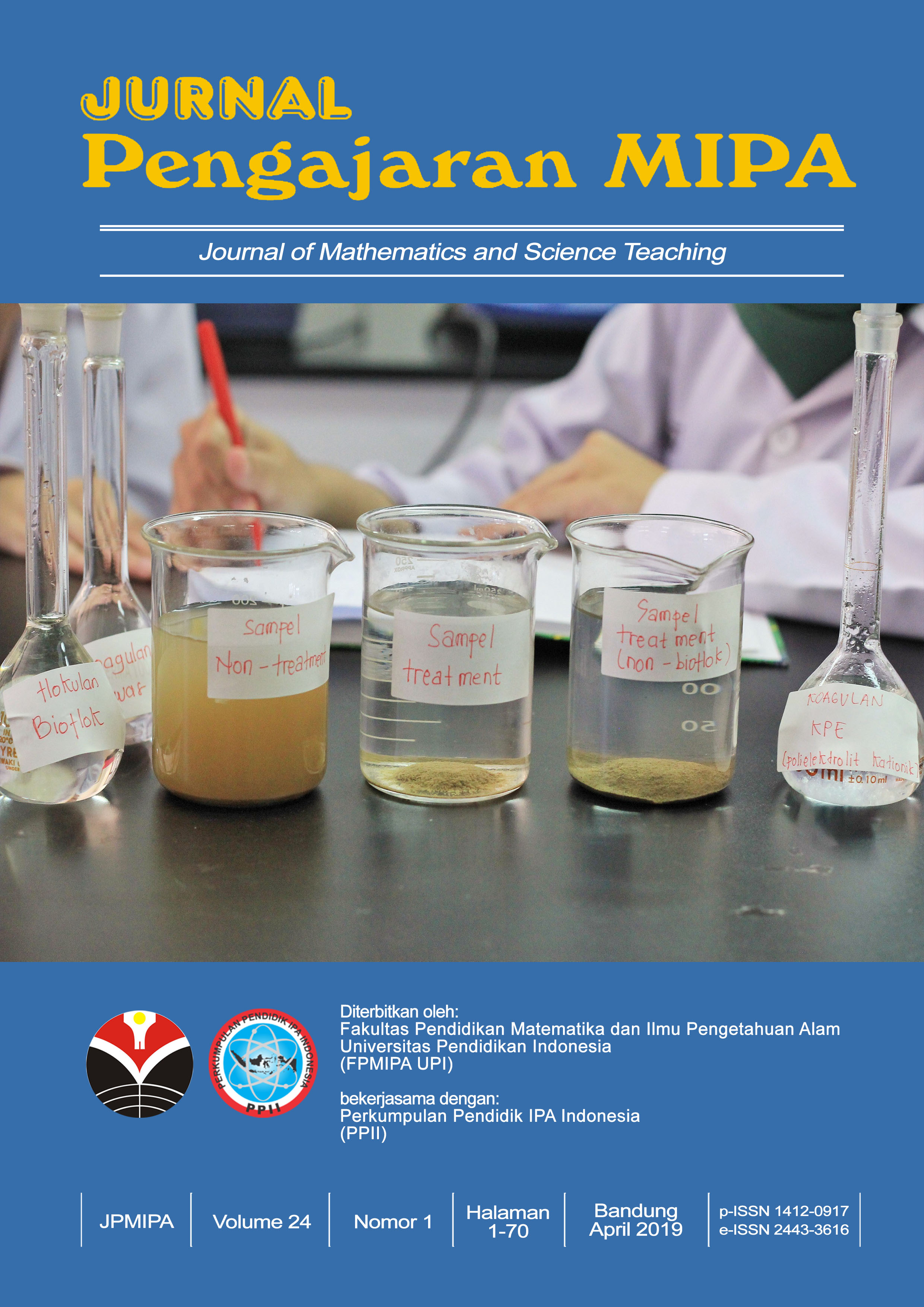ANALISIS PENERAPAN SISTEM E-LEARNING FPMIPA UPI MENGGUNAKAN TECHNOLOGY ACCEPTANCE MODEL (TAM)
Abstract
ABSTRAK
E-learning adalah kegiatan belajar yang menggunakan internet yang dapat dikombinasikan dengan kegiatan tatap muka yang ada di lembaga pendidikan. Fakultas Pendidikan Matematika dan Ilmu Pengetahuan Alam (FPMIPA) UPI telah mengembangkan sistem e-learning berbasis open source sejak tahun 2005. Penelitian ini bertujuan untuk melakukan analisis tingkat penerimaan user yaitu dosen dan mahasiswa terhadap sistem e-learning FPMIPA UPI dengan Technology Acceptance Model (TAM) melalui analisis model persamaan struktural (Struktural Equation Modeling/SEM). Hasil analisis menunjukan bahwa terdapat faktor-faktor yang saling berhubungan serta berpengaruh terhadap tingkat penerimaan e-learning FPMIPA. Perbedaan individu berpengaruh terhadap persepsi kemudahan, organisasi bahan ajar elektronik dan persepsi kemudahan berpengaruh terhadap persepsi kemanfaatan, persepsi kemudahan dan kemanfaatan berpengaruh terhadap minat, dan minat berpengaruh terhadap kondisi nyata penggunaan. Dari hasil tersebut, maka para pengguna akan senantiasa secara nyata menggunakan e-larning FPMIPA sebagai bagian dari sumber dan media pembelajaran sehari-hari. Keberadaan pemahaman akan manfaat sangat dipengaruhi oleh faktor di luar pengguna yakni organisasi bahan ajar elektronik yang dimiliki. Lain halnya untuk pemahaman akan adanya kemudahan menggunakan e-larning FPMIPA dipengaruhi oleh faktor luar yakni kondisi dari perbedaan individu pengguna.
ABSTRACT
E-learning is a learning activity that uses the internet which can be combined with face-to- face activities in the educational institutions. Faculty Education of Mathematics and Sciences of UPI has developed an e-learning system based on open source software since 2005. This study aims to analyze the level of user acceptance (lecturers and students) to the e-learning system of FPMIPA UPI with the Technology Acceptance Model (TAM) through structural equation modeling analysis (Structural Equation Modeling/SEM). The results of the analysis indicate that there are factors that are interconnected and affect the level of acceptance of e-learning of FPMIPA. Individual character affect to the perception of easeness, organization of electronic teaching material and perception effect to the perception of easeness, the perception of easeness and usefulness affect the interests, and the interests affect the real conditions of use. From these results, the user always use a real e-learning of FPMIPA as part of resources and learning media everyday. The existence of understanding to benefit greatly influenced by factors outside of user that is owned electronic materials organization. While the understanding of easeness to of use of e-larning of FPMIPA influenced by external factors, that are the condition of user individual characteristic.
Keywords
Full Text:
PDFReferences
APJII. (2009). Perkembangan Jumlah Pelanggan dan Pemakai Internet di Indonesia [Online]. Tersedia: http://www.apjii.or.id/dokumentasi /statistik.php ?lang=ind [30 April 2009].
Arbuckle, J.L. (2007). Amos™ 16.0 User’s Guide. USA: Amos Development Corporation.
Bakharuddin. (2010). Artikel Online: Pentingnya Pembelajaran yang Mengintegrasikan TIK. Tersedia di http://drs-bakharuddin.blogspot. com/2010/03/pentingnya-pembelajaran-yang.html [September 2010].
Bertrand, M. & Bouchard S. (2008). Journal l of Cyber Therapy & Rehabilitation Summer 2008 , Volume 1 , Issue 2: Applying The Technology Acceptance Model To Vr With People Who Are Favorable To Its Use. Virtual Reality Medical Institute.
Chin, W.W. (2008). A Fast Form Approach To Measuring Technology Acceptance And Other Constructs. MIS Quarterly Vol. 32 No. 4, pp. 687-703.
Clark, R. C. & Mayer, R. E. (2003). E-learning and the science of instruction. San Francisco: Jossey–Bass/Pfeiffer.
Darma, B. (2010). Artikel Online: Digital Learning System, Teknologi Pembelajaran Terbaru. Tersedia di http://smaalfa.com/Digital-Learning-System.asp.htm [Agustus 2010].
Downes, S. (2006). E-learning 2.0 [Online]. Tersedia : http://www.elearnmag.org/subpage. cfm?section=articles&article=29-1 [28 Maret 2009].
Galletta, D.F. & Malhotra Y. (1998). Extending the Technology Acceptance Model to Account for Social Influence: Theoretical Bases and Empirical Validation. Hawaii: Proceedings of the 32nd Hawaii International Conference on System Sciences – 1999.
Herlawati. (2011). Seminar Nasional Inovasi dan Teknologi (SNIT): User Acceptance Model Penggunaan Open Source Software Dalam Pembelajaran Pemrograman. STMIK Nusa Mandiri Jakarta.
Jogiyanto. (2000). Sistem Informasi Berbasis Komputer. Yogyakarta: Penerbit BPFE.
Jogiyanto. (2007). Sistem Informasi Keperilakuan. Yogyakarta: Penerbit Andi.
Joint, N. (2005). eLiteracy versus information literacy at eLit2005: what’s the difference, which should we prefer?. eLiteracy, 2(2005).
Juliandi, A. (2007). Pengujian Validitas Dan Reliabilitas. USA: Amos Development Corporation. Tersedia di http:/www.azuarjuliandi [Januari 2011].
Kuswana, S.W. (2008). Artikel Online: Model, Pendekatan, Strategi, Metode, Gaya. Tersedia di http://wowosk.com/artikel/kurpem-model.php [Agustus 2010].
MA Will W K. (2004). Implementation Strategies and the Technology Acceptance Model: Is “Ease of Use” Really Useful or Easy to Use in Implementation?. Hong Kong SAR: Information & Systems Management Department Hong Kong University of Science & Technology.
Nugroho, E.H. & Achjari D. (2004). Seminar Nasional Aplikasi Teknologi Informasi 2004: Faktor-Faktor Penentu Penggunaan WorldWideWeb sebagai Sarana Pendukung Pendidikan: Studi Empirik Mahasiswa Akuntansi Di Yogyakarta. Yogyakarta: Universitas Gadjah Mada.
O'Hear, S. (2006). E-learning 2.0 - How Web Technologies are Shaping Education. eLearn, 10(1).
DOI: https://doi.org/10.18269/jpmipa.v19i1.36165
Refbacks
- There are currently no refbacks.
Copyright (c) 2021 Jurnal Pengajaran MIPA

This work is licensed under a Creative Commons Attribution-ShareAlike 4.0 International License.
JPMIPA http://ejournal.upi.edu/index.php/jpmipa/index is licensed under a Creative Commons Attribution-ShareAlike 4.0 International License
Jurnal Pengajaran Matematika dan Ilmu Pengetahuan Alam (JPMIPA) or Journal of Mathematics and Science Teaching
All rights reserverd. pISSN 1412-0917 eISSN 2443-3616
Copyright © Faculty of Mathematics and Science Education (FPMIPA) Universitas Pendidikan Indonesia (UPI)
View JPMIPA Stats









